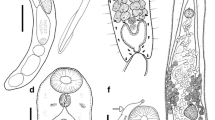Abstract
Eggs ofTrichuris muris hatched when implanted directly into the ceca of mice. The hatched larvae had penetrated the epithelium 40 min after introduction of the eggs. It is certain that the larvae penetrated the epithelium lining the cecal glands after entering the glands. Since penetration through the surface or luminal epithelium was not observed, it may be that the larvae enter gland openings selectively before penetrating epithelial cells.
Similar content being viewed by others
References
Barker IK (1975) Location and distribution ofTrichostrongylus colubriformis in the small intestine of sheep during the prepatent period, and the development of villus atrophy. J Comp Pathol 85:417–426
Barker IK, Ford GE (1975) Development and distribution of atrophic enteritis in the small intestines of rabbits infected withTrichostrongylus retortaeformis. J Comp Pathol 85: 427–435
Beer RJS (1973) Studies on the biology of the life-cycle ofTrichuris suis Schrank, 1788. Parasitology 67:253–262
Despommier DD, Sukhdeo M, Meerovitch E (1978)Trichinella spiralis: Site selection by the larva during the enteral phase of infection in mice. Expl Parasitol 44:209–215
Gardiner CH (1976) Habitat and reproductive behaviour ofTrichinella spiralis. J Parasitol 62:865–870
Jenkins T (1970) A morphological and histochemical study ofTrichuris suis (Schrank, 1788) with special reference to the host-parasite relationship. Parasitology 61:357–374
Kennedy MW, Wakelin D, Wilson MM (1979) Transplantation of adultTrichinella spiralis between hosts: worm survival and immunological characteristics of the host-parasite relationship. Parasitology 78:121–131
Kozek WJ (1976)Trichinella spiralis: size of F1 generations produced in mice by transplanted females or from infections with known numbers of male and female larvae. Rev Biol Trop 24:175–183
Lee TDG, Wright KA (1978) The morphology of the attachment and probable feeding site of the nematodeTrichuris muris (Schrank, 1788) Hall, 1916. Can J Zool 56:1889–1905
Ogren RE (1953)Capillaria blarinae n. sp. (Nematoda: Trichuridae) from the esophagus of the short-tailed shrew,Blarina brevicauda (Say). J Parasitol 39:135–138
Panesar TS, Croll NA (1980) The location of parasites within their hosts: site slection byTrichuris muris in the laboratory mouse. Int J Parasitol 10:261–273
Panesar TS, Croll NA (1981) The hatching process inTrichuris muris (Nematoda: Trichuroidea). Can J Zool 59:621–628
Pence DB (1975)Capillaria procyonis sp. n. (Nematoda: Trichuridae) from the esophagus of the racoon,Procyon lotor. J Parasit 5:815–818
Pence DB, Little MD (1972)Anatrichosoma buccalis sp. n. (Nematoda: Trichosomoididae) from the buccal mucosa of the common opossum,Didelphis marsupialis L. J Parasitol 58: 767–773
Sun S-C, Cross JH, Berg HS, Kau S-L, Singson C, Banzon T, Watten RH (1974) Ultrastructural studies of intestinal capillariasis.Capillaria phillipinensis in human and gerbil hosts. SE Asian J Trop Med Pub Hlth 5:524–533
Taylor SM, Pearson GR (1979)Trichostrongylus vitrinus in sheep. I. The location of nematodes during parasitic development and associated pathological changes in the small intestine. J Comp Pathol 89:397–403
Wakelin D (1969) The development of the early stages ofTrichuris muris in the albino laboratory mouse. J Helminthol 43:427–436
Wright KA (1979)Trichinella spiralis: an intracellular parasite in the intestinal phase. J Parasitol 65:441–445
Author information
Authors and Affiliations
Rights and permissions
About this article
Cite this article
Panesar, T.S. The early phase of tissue invasion byTrichuris muris (Nematoda: Trichuroidea). Z. Parasitenkd. 66, 163–166 (1981). https://doi.org/10.1007/BF00925723
Received:
Issue Date:
DOI: https://doi.org/10.1007/BF00925723




